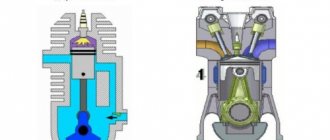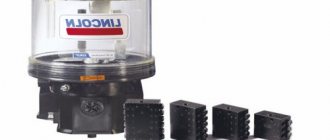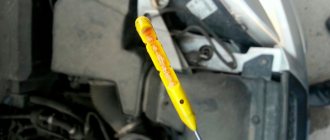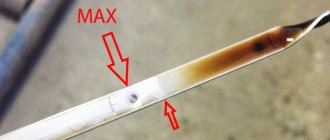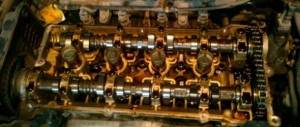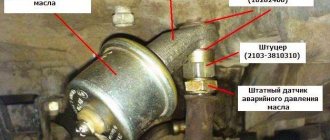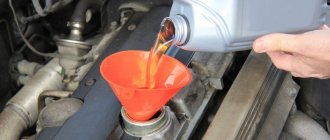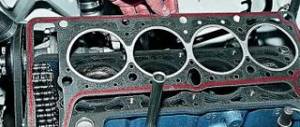The lubrication system of the engine's working components is extremely important for its proper operation. As the vehicle operates, the oil level gradually decreases. Therefore, every driver periodically has to check and add the required amount of lubricant for smooth operation of the engine. But situations arise, especially often among novice car enthusiasts, when the level of the lubricating component has increased by the maximum permissible level due to various circumstances. Therefore, a logical question arises: what to do if the oil level in the engine is higher than normal, what are the consequences?
Methods for checking auto lubrication levels
Checking the oil level
The engine oil is above the required level, what are the dangers of such a situation? Excess drops or a lack of lubricating component can cause premature wear of the working mechanisms of the power unit. Therefore, it is necessary to regularly monitor the level of consumables.
As you know, the engine fluid level is checked in the cold, preferably when the car sits outside overnight.
In the opening, near the cylinder block, there is a sealed plug. A dipstick is fixed on it, with which the oil level is checked.
In the lower zone of the measuring device there are two marks - “min” and “max”. They show the permissible amount of lubricant in the system.
The rod must be removed and wiped dry with a regular rag to remove traces of grease. Next, fix the measuring probe back into the opening until it stops. After these manipulations, the dipstick is carefully pulled out. If the car oil level on the meter shows excessive volume, then this is fraught with malfunctions. In addition, the working mechanisms of the motor are at risk. Too much lubricant can ruin the catalyst, which costs a lot of money.
If, when checking the level of the lubricant component in the engine, it is discovered that the value is below normal, this indicates that the engine, or rather the oil pump, is swallowing air and engine parts are subject to increased friction. This process is called oil starvation and is a factor in the early wear of all components of the motor system.
The ideal amount of lubricant in the power unit is when the dipstick shows that the engine oil is slightly above the minimum value.
Causes of engine oil starvation
Motorists call oil starvation the processes due to which some components of the power unit do not receive enough lubricant. Causes:
- Even in a completely serviceable new engine, some amount of lubricant is wasted. In worn drives, the volume of mixture lost to waste is much greater. Drivers who ignore checking the engine fluid level before leaving do not take into account: with each trip a certain amount of oil is lost, the mixture level gradually drops below about on the dipstick - this is critical for the engine.
- Untimely replacement of engine oil. As the mileage increases, the properties of the motor fluid change; the oil, for example, becomes thicker, stops penetrating into all components of the power unit, and “oil starvation” occurs.
- Using low-quality oil. If the engine fluid loses its original properties during operation of the power unit, this will lead to the absence of an oil film of sufficient thickness on the internal parts of the engine. The formed film will rupture as the load increases, and dry friction of the engine elements will occur. Use certified products from well-known brands.
We recommend: How often should you change the air filter in your car?
Overflow result
If the engine oil level is higher than normal, the consequences may be as follows. There is a change in the shape of seals and hermetic elements. They can no longer guarantee the quality of their work, so leaks occur. At this moment, the pressure in the propulsion system decreases, and lubricant consumption, on the contrary, increases.
In addition, sharp surges in engine oil occur, characterized by an increase in pressure in the system. As a result, a number of undesirable consequences appear:
- candles are lit;
- the ignition starts to work poorly;
- fuel consumption increases;
- Engine life decreases and power drops.
Engine oil in the engine
In cases where lubricant floods the electronic fuel consumption meter, the device begins to produce incorrect results. There is a waste of additional resources.
A high level of consumption of the lubricant component in the car’s power unit also causes foaming of the consumable material. Foam is formed as a result of the operation of the crankshaft, which is in a constant volume of lubricant. Emerging air bubbles change the homogeneity of the compositional medium. This circumstance leads to an increase in the load on the working components of the engine. Motor components wear out quickly.
Factors that increase lubrication levels
Why did the engine oil level increase? The main reason for exceeding the volume of technical fluid in a car is considered to be the human factor, that is, improper maintenance of the vehicle.
Some drivers neglect all instructions for operating the car and fill in oil according to the principle “more is better”. It is not right.
The lubricant should be poured no more than the maximum value prescribed by the manufacturer.
If motor lubricant was poured into the power device without exceeding the nominal volume, and the oil level increased during the operation of the vehicle, then a number of undesirable processes contribute to this. Reasons for increasing the optimal volume:
Blue exhaust smoke
- increased pressure level of the lubricating component due to defects in the working units of the unit. Seals are not able to cope with the situation, since they are created only under a certain pressure. The pressure level has risen, causing the engine to leak motor fluid. A complete diagnosis of the vehicle’s propulsion system is necessary to establish and “treat” the cause of the defect;
- seals are leaking. If compression diagnostics do not lead to defects, then the seals should be checked and replaced if deformed. If excessive wear of the seals has occurred in the engine system, then this factor will be indicated by blue smoke from the exhaust pipe of the vehicle during engine operation. If replacing the seals does not give a positive result, then perhaps the problem lies in the engine valve guides;
- poor compression. A decrease in this parameter occurs as a result of various contaminants entering the propulsion system. The operation of decarbonizing the power device will help restore compression. If the procedure does not give a positive result, then it is necessary to check the valves for leaks. If everything is in order here, then you should contact a vehicle maintenance service. It may be necessary to replace the piston rings or bore the cylinders;
- valve clogged. A valve problem occurs as a result of increased lubrication levels due to excessive crankcase pressure. The way out of this situation is to clean the ventilation system from unwanted contaminants.
Causes of oil starvation
Engine operation in oil starvation mode is in almost all cases accompanied by increased temperature, which must be taken into account. In addition, the oil pressure in the system can be either very low (as indicated by the oil pressure warning lamp on the instrument panel) or unstable. All this can be caused by the following reasons:
- Insufficient oil level in the pan. There is simply not enough lubricant to process all the sliding bearings, there is no oil film, and the parts run almost dry. That is why it is important to check the engine oil level at least once a week, and even more often during active use. In addition, it is necessary to carefully monitor oil leaks and, if necessary, take measures to eliminate leaks.
Engine oil dipstick (analog on top, original on bottom). Incorrect dipstick readings may not promptly indicate to the car owner that the lubrication level is insufficient.
- Using oil of unsuitable viscosity . This is a very important point, since, for example, 5w-30 oil, when used in summer, may not provide the required viscosity, engine lubrication will be insufficient, and pressure at high temperatures may drop critically. To avoid this, you must follow the car manufacturer's recommendations when choosing motor oils.
- The oil receiver screen is clogged. The oil pump is not able to overcome the resistance of a clogged mesh, so oil cannot be supplied in the required quantity and under the required pressure to all components. The same applies to clogged oil lines. The ideal way out of this situation is to disassemble and mechanically clean the channels and oil receiver; flushing agents can only make things worse.
Oil pan clogged with dirt
- Irregular or untimely oil and filter changes. Each brand of oil has its own resource, which must be strictly observed. During operation, the lubricant loses most of its lubricating properties and by the end of its service life it can be almost completely oxidized and lose viscosity.
Disassembling the oil filter
- Wear of oil scraper rings and increased oil consumption . Wear of valve stem seals and crankshaft seals will also lead to high oil consumption.
- Poor quality engine assembly after repair . A competent motor mechanic will never use sealant where a simple gasket is enough - the fact is that excess sealant is pressed not only outward, but also into the oil channels, clogging them over time.
- Failure or clogging of the lubrication system pressure reducing valve.
- Oil filter clogged.
We recommend: Wires for lighting a car: choosing the best
Methods for eliminating overflow
How to fix the problem if the engine oil level is high? There are several ways to eliminate excess motor fluid.
Medical syringe and dropper
Draining oil using a syringe
With the help of simple devices that are available for free sale, you can get rid of overflow. You will need a tube for transfusion of a chemical solution and a regular medical syringe.
The operating principle is as follows:
- the end of the dropper hose must be connected to the syringe;
- the other end of the tube should be inserted into the opening of the oil dipstick;
- collect excess oil.
In practice, sometimes drivers wrap the dropper tube with electrical tape for greater weight and stability when placing it in the meter opening. Situations have also been noticed when, instead of a medical syringe, the role of a pump is played by a person’s mouth.
The operation is considered complete when the required oil level is reached.
Drain hole in the crankcase
Excess motor fluid in the system can be eliminated by draining the engine. To carry out this operation, you need to have unnecessary rags and a free, clean container. The container can be a basin or half of an old canister. The operating principle of ridding the system of excess drops of engine oil is constructed as follows:
Engine oil drain
- secure the car under an inspection hole or on an overpass;
- turn off the car, all operations are carried out on a cold engine. This is done to avoid accidental burns when draining a hot consumable;
- remove the drain plug;
- a pre-prepared oil tank must be placed under the drain;
- draining is carried out until all excess lubricant is removed;
- the drain plug is fixed back into the engine crankcase;
- lubricant is added to the required value.
Bottom line
If the engine oil level is higher, this threatens the vehicle's powertrain with malfunction in the future. If the volume is exceeded even by a small amount, the consequences will not be long in coming. Therefore, in order for a car to serve its owner faithfully for a long time, it is necessary to observe a number of simple factors, and constantly. Such procedures include regularly checking the oil level, especially if you plan to travel in mountainous areas, to avoid air getting into the oil intake.
The optimal level of the lubricating component is set by the machine manufacturer - these are the minimum and maximum value marks. The main thing is to keep the lubricant level between these indicators. Everything is in the hands of the driver.
Signs of engine oil overflow
There are few such signs, and all of them are very familiar to automotive professionals. One of the most commonly used is to check the oil level with a dipstick, for which the car is placed on a level place and allowed to cool for at least 20 - 30 minutes. After which the dipstick shows whether there is an overflow of oil, whether its level is raised above the maximum required o. This method is, according to experts, the most accurate and should be in the permanent arsenal of any motorist. Another unambiguous sign of oil overflow is increased, compared to normal, fuel consumption for no apparent reason. This is explained by the fact that with an excess of oil, the pistons and piston rings moving in the cylinders begin to encounter noticeable resistance from it, the crankshaft rotates with difficulty, and the efficiency of their actions immediately drops sharply. Then the driver, not understanding what happened to the engine, begins to automatically “add gas,” and this is a direct path to irrational overconsumption of expensive fuel. The force load on oil seals and many other parts also increases, accelerating their wear and increasing the likelihood of premature failure. Other “signals” of oil overflow include difficulty starting the engine, especially in the cold season, increased formation of unpleasant carbon deposits in the engine cylinders, deposits of coke and other harmful deposits.

